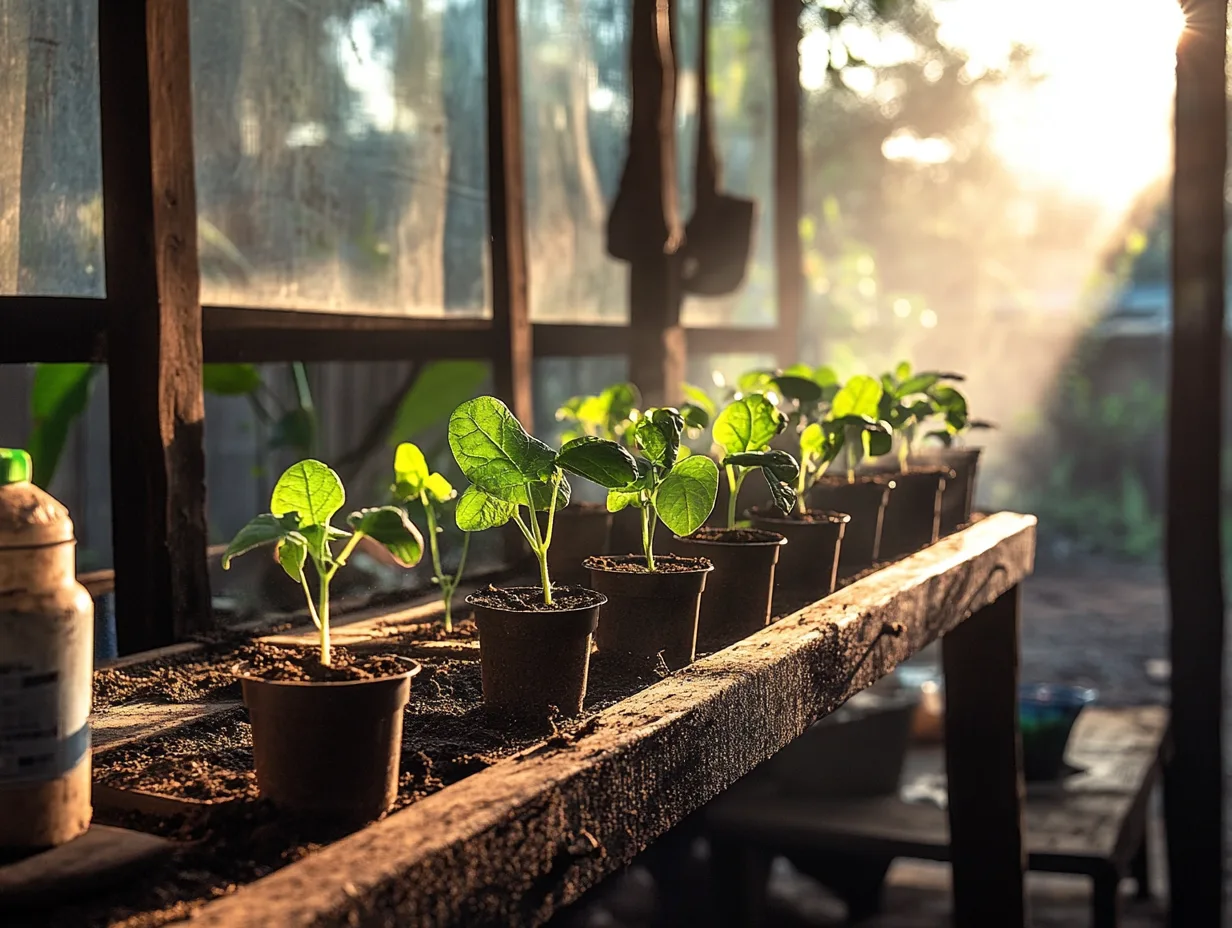Unlocking Resilience with “The Year-Round Vegetable Garden for Beginners”
Seedling Hardening Off is a transformative step in vegetable gardening, bridging the gap between cozy indoor environments and the real-world conditions of your outdoor plot. By gradually acclimating delicate seedlings to temperature shifts, sunlight exposure, and wind, you help them develop sturdier stems, stronger root systems, and overall resilience. In other words, it’s the difference between wobbly transplants that might wither in the first cold snap and robust, productive plants that can withstand surprises from Mother Nature. This comprehensive guide will arm you with everything you need to know about the hardening-off process—timelines, techniques, and troubleshooting—so you can maximize the survival and performance of your precious starts.
Why Seedling Hardening Off Is Crucial
Transitioning young plants from an indoor seed-starting setup to an outdoor garden can be a shock if done too abruptly. Gentle exposure to natural elements not only toughens them but also primes them for optimal growth in your vegetable beds.
Key Benefits for Vegetable Seedlings
- Stronger, Thicker Stems
When seedlings face gentle breezes and cooler nights during hardening off, they develop robust stems better able to support mature foliage and fruits. - Improved Root Growth
The gradual shift in ambient conditions stimulates root systems to explore and anchor more aggressively in the soil. - Enhanced Disease and Pest Resistance
Healthy plants grown under natural light cycles and breezy conditions are often less susceptible to damping-off or pest infestations, giving you a head start on the growing season. - Reduced Transplant Shock
Sudden changes in light or temperature can stunt plants for weeks. Hardening off helps them handle replanting with minimal stress, fueling faster establishment in their permanent homes.
For additional insights on preparing seedlings from the earliest stages, check out our article on Vegetable Gardening for Beginners, which covers fundamental seed-starting and soil preparation strategies.
Recognizing the Right Time to Start Hardening Off
Seedling Hardening Off is a timed process. Start too early, and a late frost or unpredictable cold snap might damage or kill your seedlings. Wait too long, and you risk crowding your indoor growing area and slowing your next batch of starts.
Signs Your Seedlings Are Ready
- Multiple Sets of True Leaves
Once seedlings have developed two or three pairs of true leaves (beyond the cotyledons), they have enough leaf area to photosynthesize effectively outdoors. - Root Bound in Containers
If roots are circling inside the pot, it’s a sign they need more space—either a larger container or a spot in the garden bed. - Stable Indoor Growth
Healthy, upright plants that no longer lean or topple under indoor lighting conditions. If your seedlings are still leggy, consider adjusting your grow lights or spacing them out.
Coordinating with Your Climate
- Post-Frost Safety
Typically, you want to start the Seedling Hardening Off process about one to two weeks before the average last frost date in your region. - Weather Forecasting
Keep an eye on sudden temperature drops or heavy winds. Postpone any extended outdoor exposure if a cold front is moving in. - Soil Temperature
For heat-loving crops like tomatoes or peppers, check that garden soil has warmed to at least 50–60°F (10–15.5°C).
The Step-by-Step Hardening Off Process
An effective approach to Seedling Hardening Off takes place over 7 to 14 days, gradually exposing plants to increasing durations of natural elements.
Day-by-Day Breakdown
- Day 1–2
- Duration: 2–3 hours
- Location: Shady or partially shaded outdoor area, sheltered from wind.
- Action: Bring seedlings outside mid-morning when temps are milder. Return them indoors well before evening chill sets in.
- Day 3–4
- Duration: 4–5 hours
- Location: Continue with partial shade but introduce a brief period of morning sunlight.
- Action: Ensure plants stay hydrated as outdoor air can dry seedlings more quickly than indoor conditions.
- Day 5–6
- Duration: 6–7 hours
- Location: Increase exposure to direct sunlight, focusing on early morning or late afternoon to avoid peak midday heat.
- Action: Monitor temperatures closely. If the wind picks up, provide a windbreak or relocate seedlings temporarily.
- Day 7–9
- Duration: 8–10 hours
- Location: Give them longer stints in full sunlight, if they’re sun-loving crops, or partial shade for varieties sensitive to harsh rays.
- Action: Begin leaving them outside into the early evening if temperatures remain above 55°F (13°C).
- Day 10–14
- Duration: 12+ hours or overnight if weather permits
- Location: By this point, most seedlings can handle near-full sunlight and moderate breezes.
- Action: If nights stay above 50°F (10°C), consider leaving plants out. This final step cements their readiness for in-ground transplanting.
Continuous Observations
- Check for Wilting
If leaves droop or turn pale, move the seedlings to a more sheltered spot and ensure they have adequate moisture. - Adjust Watering
Outdoor conditions often require more frequent watering— especially if you’re in a sunny, windy climate. - Monitor for Pests
Slugs, snails, or even curious pets may take an interest in your young plants once they’re outdoors.
For specifics on how to handle seedlings in colder conditions, our Seasonal Gardening: What to Plant and When post provides additional timing insights for frost-hardy and frost-tender varieties.
Common Mistakes During Seedling Hardening Off
Even with a solid plan, unforeseen missteps can still occur. Recognizing potential pitfalls ahead of time can save you from losing an entire tray of precious seedlings.
Moving Too Quickly
- Shock Response
Rapid exposure to harsh sunlight or cold nights may cause leaf scorching or stunted growth. Resist the urge to accelerate the schedule just because your calendar is tight.
Overlooking Weather Swings
- Late Frost Surprises
Spring weather can be unpredictable. Keep protective covers (e.g., row covers or old sheets) ready in case of unexpected dips in temperature.
Neglecting Wind and Rain
- Physical Damage
Tender stems can snap or bend under gusty conditions or heavy rain. Provide a small windbreak or shelter if storms are forecast.
Failing to Monitor Soil Moisture
- Over- or Under-Watering
Outdoor air and sunlight can dry containers faster than you’d expect. Conversely, overwatering can lead to fungal issues. Strike a balance by feeling the top inch of soil daily.
Selecting the Perfect Outdoor Location for Transition
Seedling Hardening Off typically culminates in planting out into a well-chosen spot. Each variety—lettuce, tomatoes, cucumbers—thrives under specific conditions, so plan accordingly.
Evaluating Sunlight Exposure
- Full Sun
Warm-season crops (tomatoes, peppers, squash) flourish with 6–8 hours of direct sun daily. - Partial Shade
Leafy greens and some root vegetables can tolerate less intense light, especially in hotter climates.
Soil Preparation
- Organic Matter
- Incorporate compost or well-rotted manure to boost fertility and improve drainage.
- PH Balance
- Aim for soil around pH 6.0–7.0 for most vegetables. See our Soil pH Testing: Mastering Balance for Vibrant Vegetables for an in-depth guide on ensuring optimal acidity or alkalinity.
- Weed Control
- Clear weeds thoroughly before planting to reduce competition for nutrients and water.
Spacing and Companion Planting
- Proper Spacing
Overcrowding fosters disease and hinders airflow. Check seed packets or references for recommended distances between plants. - Companion Herbs and Flowers
Integrate beneficial companions—like basil near tomatoes or marigolds to repel pests—to encourage pollinators and reduce pest pressures.
Watering and Feeding Newly Transitioned Seedlings
Post-transplant care is as crucial as the hardening-off process itself. Well-timed watering and light feeding minimize shock and establish vigorous root systems.
Immediate Water Needs
- Soak the Root Zone
Right after transplanting, water thoroughly to settle soil around roots and eliminate air pockets. - Mulch to Conserve Moisture
A layer of straw, wood chips, or grass clippings helps maintain consistent soil moisture and temperature.
Fertilizer Strategy
- Gentle Start
- For the first week, avoid heavy fertilizers that might burn tender roots. Opt for a mild compost tea or diluted fish emulsion if needed.
- Adjust to Plant Maturity
- As seedlings take off, use a balanced organic fertilizer to support leaf and stem growth.
- Avoid Excess Nitrogen
- Leafy vegetables might relish more nitrogen, but fruiting plants (like tomatoes) need a balanced approach to develop flowers and fruits.
Troubleshooting Issues After Hardening Off
Sometimes, even carefully hardened-off seedlings face unexpected challenges once they’re in the garden. Knowing what to look for can help you remedy problems quickly.
Signs of Stress in Transplanted Seedlings
- Yellowing Leaves
Possibly indicative of insufficient nitrogen, water stress, or root damage. Investigate soil moisture and nutrient availability. - Wilting in Heat
If seedlings droop midday but recover by evening, they may simply be adjusting to stronger sunlight. Provide temporary shade if severe. - Sluggish Growth
This can result from compacted soil, hidden pest issues, or suboptimal temperatures. Gently aerate soil or add organic matter if necessary.
Seeking Expert Help
- Extension Services
In many regions, local agricultural extension offices offer free or low-cost consultations. - Online Gardening Forums
Communities like the American Horticultural Society or local Facebook groups can provide tailored advice. - Garden Journals
Keeping records of planting dates, weather patterns, and interventions can pinpoint recurring issues and guide future improvements.
Exploring Further Resources
If you’re finding success with Seedling Hardening Off and want to deepen your horticultural skills, consider diving into more advanced topics.
Crop Rotation and Soil Health
- Why It Matters
Rotating plant families helps reduce pest cycles and maintain balanced soil fertility. - How to Implement
Move tomatoes, peppers, and eggplants to new beds yearly, followed by legumes or leafy greens.
Season Extension Techniques
- Cold Frames and Row Covers
Protect plants from unexpected frosts and extend the harvest window by weeks, letting you plant seedlings earlier or keep them thriving later. - Greenhouses
For those with serious year-round growing ambitions, a greenhouse offers control over temperature, humidity, and light.
Reference Materials
For a detailed exploration of advanced seed-starting and transplanting techniques, check out Benjamin Greenfield’s The Year-Round Vegetable Garden for Beginners. This comprehensive resource delves into everything from specialized lighting setups to pest management, helping you elevate your entire gardening approach.
Summarizing the Seedling Hardening Off Process
Seedling Hardening Off is an integral practice that ensures your plants safely transition from controlled indoor environments to the unpredictable realities of outdoor gardening. Over a span of one to two weeks, incremental exposure to sunlight, wind, and fluctuating temperatures coaxes seedlings into developing the resilience they need to thrive in open soil. By timing the process carefully—taking note of local frost dates and climate patterns—you can minimize transplant shock, stave off pests, and set the stage for vigorous growth. Consistent watering, mindful fertilization, and a vigilant eye for temperature swings round out your success. Ultimately, this extra effort pays off with healthier, sturdier plants that reward you with abundant harvests all season long.


Leave a Reply